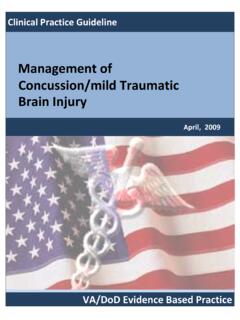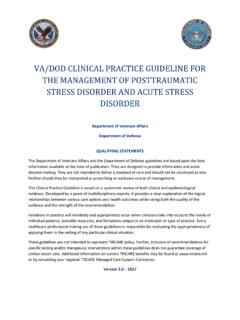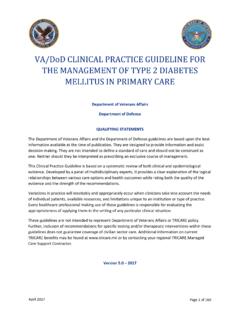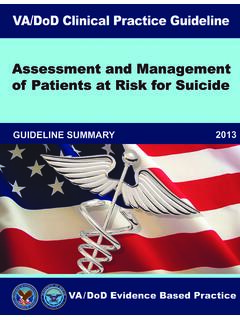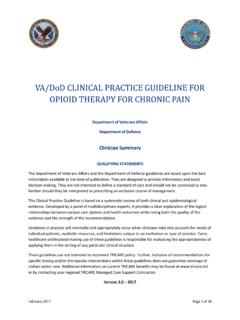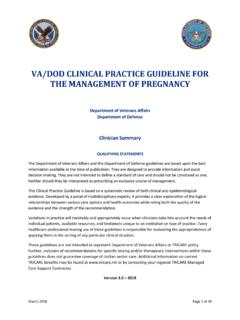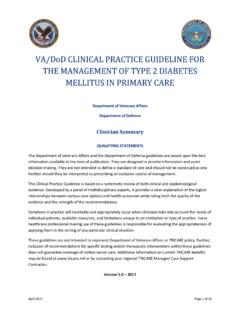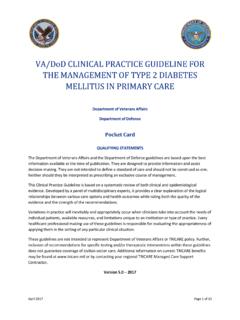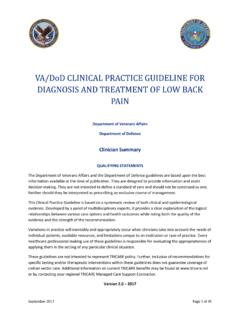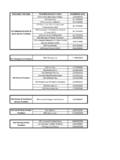Transcription of VA/DoD Major Depressive Disorder Clinical Practice …
1 VA/DoD Clinical Practice GUIDELINE FOR. THE MANAGEMENT OF Major Depressive . Disorder . Department of Veterans Affairs Department of Defense QUALIFYING STATEMENTS. The Department of Veterans Affairs and the Department of Defense guidelines are based upon the best information available at the time of publication. They are designed to provide information and assist decision making. They are not intended to define a standard of care and should not be construed as one. Neither should they be interpreted as prescribing an exclusive course of management. This Clinical Practice Guideline is based on a systematic review of both Clinical and epidemiological evidence. Developed by a panel of multidisciplinary experts, it provides a clear explanation of the logical relationships between various care options and health outcomes while rating both the quality of the evidence and the strength of the recommendation.
2 Variations in Practice will inevitably and appropriately occur when clinicians take into account the needs of individual patients, available resources, and limitations unique to an institution or type of Practice . Every healthcare professional making use of these guidelines is responsible for evaluating the appropriateness of applying them in the setting of any particular Clinical situation. These guidelines are not intended to represent TRICARE policy. Further, inclusion of recommendations for specific testing and/or therapeutic interventions within these guidelines does not guarantee coverage of civilian sector care. Additional information on current TRICARE benefits may be found at or by contacting your regional TRICARE Managed Care Support Contractor. Version 2016. VA/DoD Clinical Practice Guideline for the Management of Major Depressive Disorder Prepared by: The Management of Major Depressive Disorder Working Group With support from: The Office of Quality, Safety and Value, VA, Washington, DC.
3 &. Office of Evidence Based Practice , Army Medical Command Version 2016. Based on evidence reviewed through January 2015. April 2016 Page 2 of 173 . VA/DoD Clinical Practice Guideline for the Management of Major Depressive Disorder Table of Contents I. Introduction ..5. II. Background ..5. A. Major Depressive Disorder .. 5. B. Depression in the General 6. C. Depression in the VA/DoD Populations .. 6. III. Scope of the A. Target Population .. 7. B. Audiences .. 7. C. Outcomes of Interest .. 7. D. Goals of the Guideline .. 7. IV. About this Clinical Practice Guideline ..8. A. 8. B. Conflict of Interest .. 11. C. Highlighted Features of this CPG .. 11. D. Patient-centered Care .. 12. E. Knowledge Gaps and Future Directions .. 12. F. Implementation .. 13. V. Guideline Working Group .. 14. VI. Algorithm .. 15. VII. Recommendations .. 17. A. 21.
4 B. Assessment and Triage .. 22. C. Treatment Setting .. 26. D. Management .. 28. E. Other Treatment 43. Appendix A: Evidence Review Methodology .. 59. A. Developing the Scope and Key Questions .. 59. B. Conducting the Systematic Review .. 60. C. The Face-to-Face Meeting .. 82. D. Grading Recommendations .. 82. E. Recommendation Categorization .. 85. April 2016 Page 3 of 173 . VA/DoD Clinical Practice Guideline for the Management of Major Depressive Disorder F. Drafting and Submitting the Final Clinical Practice Guideline .. 87. Appendix B: Quick Guide to the Patient Health Questionnaire (PHQ).. 89. A. Purpose .. 89. B. Scoring the 89. Appendix C: Pharmacotherapy .. 93. Appendix D: Definitions .. 100. A. Major Depressive Disorder .. 100. B. Treatments .. 102. Appendix E: Evidence Table .. 104. Appendix F: 2009 Recommendation Categorization.
5 110. Appendix G: Participant List .. 158. Appendix H: Abbreviation List .. 160. 163. April 2016 Page 4 of 173 . VA/DoD Clinical Practice Guideline for the Management of Major Depressive Disorder I. Introduction The Department of Veterans Affairs (VA) and the Department of Defense (DoD) Evidence-Based Practice Working Group (EBPWG) were established and first chartered in 2004, with a mission to advise the Health Executive Council on the use of Clinical and epidemiological evidence to improve the health of the population across the Veterans Health Administration (VHA) and Military Health System, by facilitating the development of Clinical Practice guidelines (CPG) for the VA and DoD populations.[2] This CPG is intended to provide primary care clinicians with a framework by which to evaluate, treat, and manage the individual needs and preferences of patients with Major Depressive Disorder (MDD), thereby leading to improved Clinical outcomes.
6 In 2009, the VA and DoD published a CPG for the Management of Major Depressive Disorder (2009 MDD. CPG), which was based on evidence reviewed through 2007. Since the release of that guideline, a growing body of research has expanded the general knowledge and understanding of MDD and its management. Recognition of the complex nature of this condition has led to the adoption of new strategies to manage and treat patients with MDD, including new developments related to pharmacotherapy and other treatment options. Consequently, a recommendation to update the 2009 MDD CPG was implemented in 2014. The updated CPG includes objective, evidence-based information on the management of MDD. It also brought diagnostic criteria for MDD in congruence with the Diagnostic and Statistical Manual of Mental disorders , fifth edition (DSM-5). It is intended to assist healthcare providers in all aspects of patient care including, but not limited to, diagnosis, treatment, and follow-up.
7 The system-wide goal of evidence- based guidelines is to improve the patient's health and wellbeing by guiding health providers who are taking care of patients with MDD along the management pathways that are supported by evidence. The expected outcomes of successful implementation of this guideline are to improve how providers: Assess the patient's condition and determine the best treatment method Optimize the use of therapy to improve symptoms and functioning, treatment of the condition's acute phase, prevent relapse, and improve both health and quality of life outcomes Minimize preventable complications and morbidity Emphasize the use of patient-centered care II. Background A. Major Depressive Disorder Depression is a common mental Disorder that presents with depressed mood, loss of interest or pleasure in regular activities, decreased energy, feelings of guilt or low self-worth, disturbed sleep or appetite, and poor concentration.
8 Major Depressive Disorder is the most prevalent and disabling form of depression. In addition to the immediate symptoms of depression, MDD results in poor quality of life overall, decreased productivity, and can increase mortality from suicide. Social difficulties including stigma, loss of employment, and marital conflict as a result of depression can also occur. Anxiety, April 2016 Page 5 of 173 . VA/DoD Clinical Practice Guideline for the Management of Major Depressive Disorder posttraumatic stress Disorder (PTSD), and substance misuse are common co-occurring conditions that may worsen the existing depression and complicate treatment. Depression is considered to be a largely biological illness but can result from a combination of genetic, biological, environmental, and psychological factors. Trauma, loss of a loved one, a difficult relationship, or any stressful situation may trigger depression, but depression can also occur without an obvious trigger.
9 B. Depression in the General Population According to the National Alliance on Mental Illness, an estimated 16 million American adults almost 7% of the population had at least one Major Depressive episode in the past year. Women are 70%. more likely than men to experience depression, and young adults aged 18 25 are 60% more likely to have depression than people aged 50 or older.[3] Depressive disorders often start at a young age; they reduce people's functioning and often recur.[4] According to the World Health Organization (WHO), MDD (identified as unipolar Depressive disorders by WHO) ranked first worldwide among the leading causes of disability ( , aggregate years lived with disability [YLD]).[5]. The incremental economic burden of individuals with MDD was $ billion in 2010, in both direct and indirect costs, compared to $ billion in 2005, an increase of over this period.
10 [6] Additionally, co-occurring conditions accounted for a larger percentage of the economic burden of MDD than the MDD itself. Although depression can be a devastating illness, it often responds to treatment. There are a variety of treatment options available for people with depression including drugs and psychotherapy. Depression is frequently underdiagnosed, however; among people with severe Depressive symptoms, for example, only about one-third (35%) had seen a mental health professional for treatment in the past year.[7]. C. Depression in the VA/DoD Populations Military personnel are prone to depression, at least partially as a result of exposure to traumatic experiences, including witnessing combat and separation from family during deployment or military trainings.[8,9] For example, based on data collected in 2011 from a de-identified cross-sectional survey of active duty soldiers, The Army Study to Assess Risk and Resilience in Servicemembers (Army STARRS).
